
Here, we’ve gathered 8 real-world examples of how multiphysics simulation is being used to help the environment and make the world a more sustainable place. The stories featured here highlight the importance of simulation in the production of electric vehicles, energy-efficient ovens, biofuel, and more.
1. Designing Electric Vehicle Components
In recent years, you might’ve noticed a surge in the amount of charging stations available for electric vehicles — it almost seems as if every parking lot has them. This trend will only continue to grow as electric vehicles (EVs) are on track to become the transportation mode of choice over conventional internal combustion engine vehicles. Consumers are expressing concern for their environment and want to invest in a vehicle that produces less air pollution.
One company advancing the development of electric vehicles is Volkswagen, whose Kassel plant in Germany specializes in the design and production of EVs. This automaker uses the COMSOL Multiphysics® software to analyze the strength of rotor laminations, a crucial piece in all electric drives. The group also builds and distributes simulation applications throughout the organization to:
- Automate the test process for rotors
- Increase product quality
- Help develop commercially available electric vehicles faster
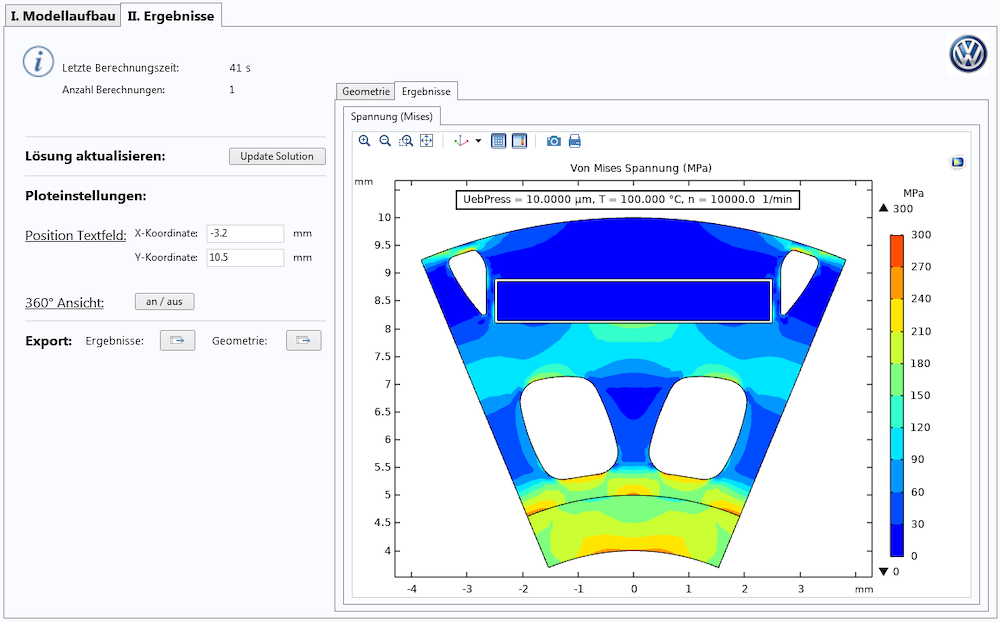
Standardized stress results for the rotor.
Read the full story here: “Simulation Applications Streamline The Development of Electric Vehicle Motors”
2. Preserving Lake Water Environments
Across the world, lakes are considered an essential part of Earth’s freshwater supply. These bodies of water are found in every environment, no matter how hot or cold. Lakes are also home to thousands of wildlife, including fish, turtles, frogs, and alligators.
Every year, these peaceful water environments become more popular vacation destinations. This increased human activity is one way that these lakes are robbed of their oxygen, and this oxygen-deficient water often contains elevated levels of toxic substances. One environmentally friendly way to treat contaminated water in lakes and dams is to inject them with microbubbles filled with oxygen.
One researcher from Ritsumeikan University used simulation to help determine the best and most cost-efficient way to inject microbubbles into the Sounoseki Dam in Japan. Before coming to a solution, they needed to predict the behavior of the different environmental phenomena affecting the dam, including:
- Water flow
- Temperature
- Chemical reactions
- Diffusion
- Wind
The researcher used COMSOL Multiphysics to determine the location, depth, and speed to introduce the microbubbles into the dam.

Simulating microbubbles in a reservoir. Image courtesy of Dr. Shuya Yoshioka.
Read the full story here: “Restoration of Lake Water Environments”
3. Improving the Energy Efficiency of Buildings
Heating and Cooling Systems
A large portion of energy consumption in the world stems from the heating and cooling of buildings. One way to help conserve energy while heating and cooling buildings is to use adsorption-based heating and cooling systems, which are driven by heat instead of electricity. Absorptive climate control systems can reduce electricity usage and associated CO2 emissions. However, the development of these systems is challenging because they have:
- Discontinuous operating cycles
- Varying peak energy fluxes
- Dynamic behavior, which is determined by complex and coupled heat and mass transfer phenomenon
Researchers at Fraunhofer Institute for Solar Energy Systems (ISE) used numerical simulation and experiments to analyze and design optimized heat exchangers for these adsorption systems. The researchers used COMSOL Multiphysics to model water vapor and heat transfer through solids, which led to an improved exchanger geometry.

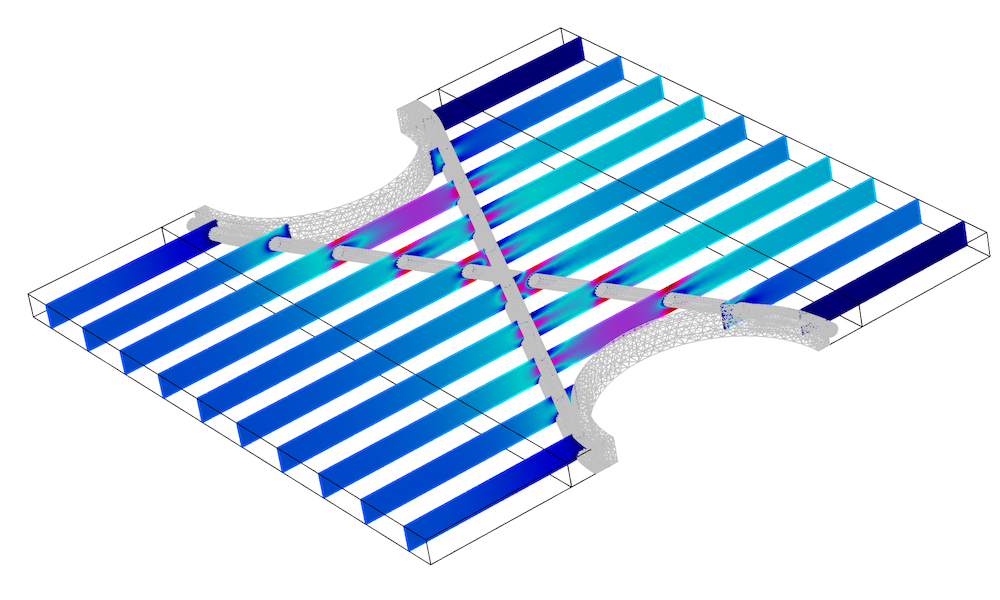
Simulation results show velocity streamlines and temperature distribution in the air, tubes, and wires (left) and velocity magnitude in the air (right). Copyright © Fraunhofer ISE.
Read the full story here: “Better Ways To Heat and Cool Buildings”
Fenestration Systems
Fenestration, or any opening in a building envelope, includes the installation of windows, doors, and skylights. Fenestration is important because it helps improve comfort for occupants, enhances buildings’ overall aesthetic, and provides a place to enter and exit buildings. Components of fenestration systems, such as frames, glass, and shading attachments, can even improve a building’s energy efficiency. For example, these components can help control sunlight and heat gain, which can help decrease the demand for heating, cooling, and artificial light in a building.
Scientists at Eurac Research used heat transfer and fluid flow simulation to help design optimized fenestration systems. The researchers found COMSOL Multiphysics to be an accurate and beneficial tool for analyzing heat flow through a complex fenestration system. Their work on fenestration systems can help improve the energy efficiency of buildings and enhance visual and thermal comfort for occupants.
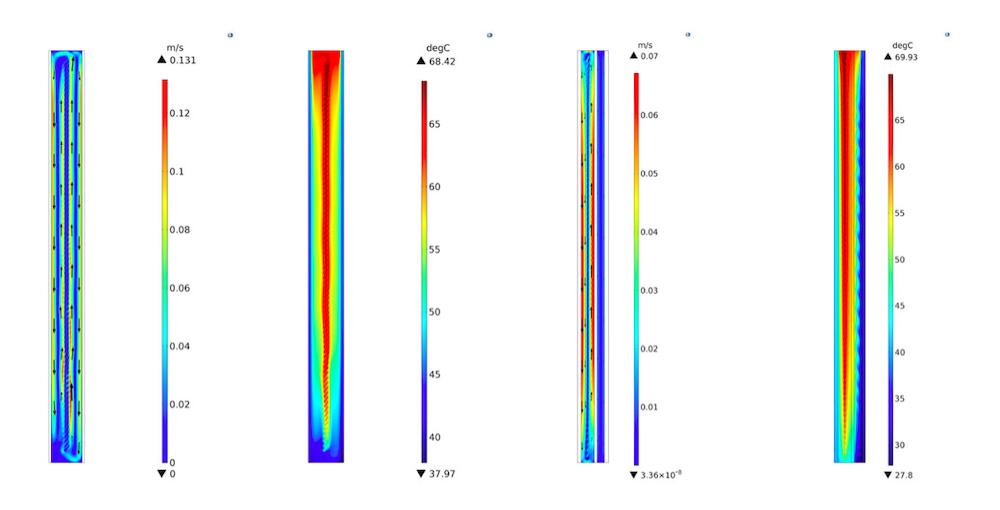
CFD results showing how convection affects the temperature of a window in a standard fenestration system (left) and a complex fenestration system (right).
Read the full story here: “Complex Fenestration System for Energy Efficiency”
4. Safeguarding Nuclear Waste Storage Facilities
Nuclear waste can cause detrimental effects for life on Earth. High levels of nuclear waste exposure are especially dangerous because it can lead to birth defects, cancer, and even death. The negative impacts of radioactive waste can last for thousands of years, which is why it is imperative that the waste is safely stored. Nuclear waste storage facilities often keep this hazardous material enclosed in tight steel drums encased in concrete. However, these steel drums are not immune to corrosion, which is why it is essential that corrosion at these facilities is completely prevented.
Sogin S.p.A., an Italian state company responsible for nuclear decommissioning and the management of radioactive waste, uses simulation to help design energy-efficient dehumidification systems. These systems are used to prevent corrosion in drums of low-level radioactive waste. Using COMSOL Multiphysics and the Heat Transfer Module, the company was able to develop a layout for two dehumidifier designs to:
- Reduce stagnant air pockets
- Enable the units to operate at maximum efficiency
- Help lower the risk of drum corrosion
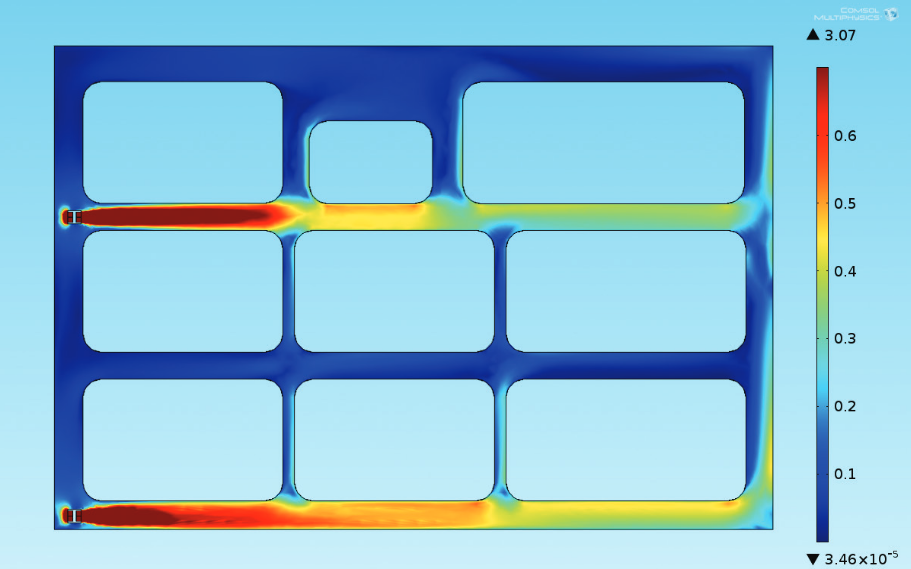
Simulation results showing airflow velocity in the storage area.
Read the full story here: “Battling Corrosion in Nuclear Waste Storage Facilities”
5. Reducing Energy Consumption in the Food Industry
Food Transportation Vehicles
On a global scale, the food sector is among the top five energy-consuming industries and is responsible for 37% of greenhouse gas emissions. Food transportation vehicles, like refrigerated truck trailers, are one of the larger contributing factors to the food industry’s growing energy consumption. Refrigerated vehicles typically have low energy efficiency and depend on conventional diesel-engine-driven refrigeration units. One way to help minimize the environmental footprint of food transportation is to design refrigerated systems that run on clean energy technologies.
Sunwell Technologies Inc., a leading global provider of advanced food preservation and cooling technology, developed refrigerating systems that run on Deepchill™ thermo batteries. The Deepchill™ thermo battery is a rechargeable and more environmentally friendly method than conventional ways of keeping refrigerator systems chilled. To help optimize their thermo battery designs, Sunwell Technologies Inc. collaborated with the Computational Multiphase Flow group at the University of Massachusetts Dartmouth.
The Computational Multiphase Flow group used multiphysics simulation to support Sunwell’s experimental efforts involving their thermo battery technology. The group carried out simulations of heat transfer and fluid dynamics in the refrigerated system using COMSOL Multiphysics. The models used in their simulation allowed for the group to investigate:
- Specific design criteria
- Average and maximum temperatures of specific domains
- Insulation performance and natural convection

The natural convection and temperature distribution during cooling of a refrigeration unit by using the Deepchill™ thermo batteries.
Read the full story here: “Cluster Simulation of Refrigeration Systems”
Sustainable Ovens
What’s essential for baking cookies, contains several racks, and can consume a lot of energy? If you guessed conventional ovens, you’d be correct. This kitchen appliance only uses about 10–12% of its input power to heat the food it’s preparing. Fortunately, more sustainable oven options are becoming available.
One company looking into improving the resource efficiency of their domestic ovens is Whirlpool Corporation, the world’s largest home appliance manufacturer. Researchers at Whirlpool R&D studied the oven’s energy consumption by looking into the heat transfer processes of:
- Convection
- Conduction
- Radiation
Using COMSOL Multiphysics, the researchers could visualize the heat transfer processes that occur within a domestic oven and test new strategies for upping the energy efficiency of their oven designs.
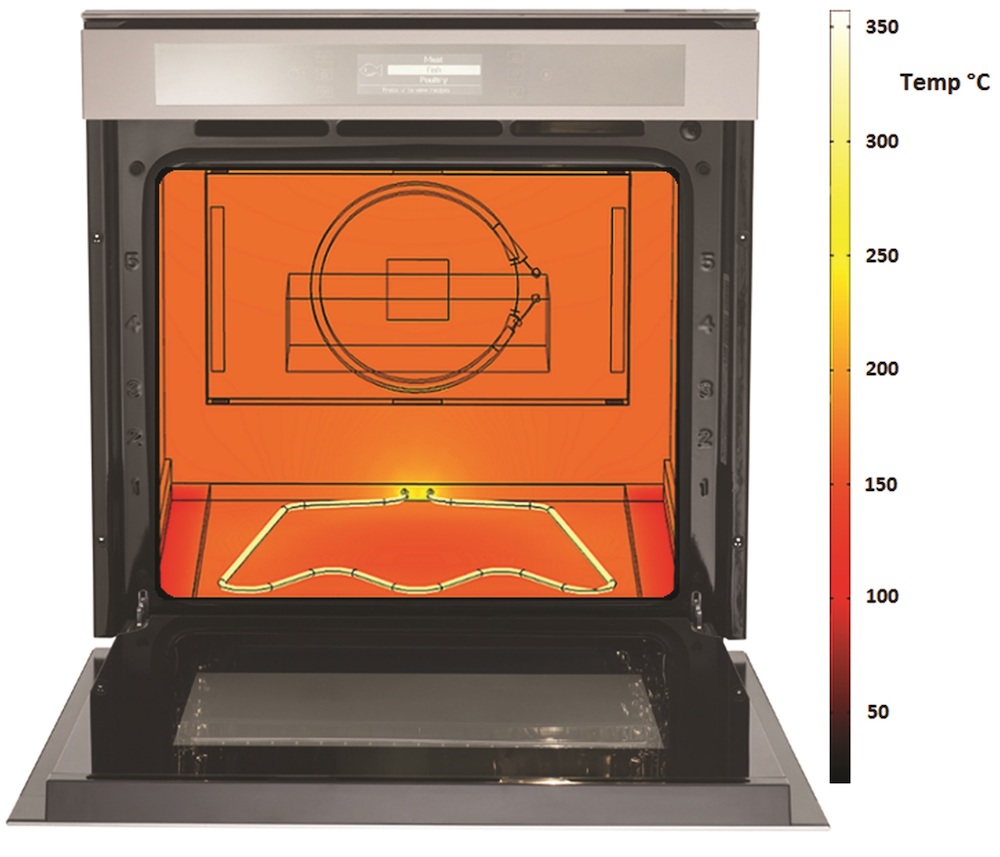
Model of Whirlpool’s Minerva oven showing the predicted temperature distribution of the oven’s surfaces.
Read the full story here: “Simulation Turns Up The Heat and Energy Efficiency at Whirlpool Corporation”
6. Accelerating Biofuel Production
A potential replacement for fossil fuels comes in the form of a renewable source of energy: biofuel. This alternative energy source produces less pollution, while still having the capacity to heat buildings, generate electricity, and fuel the transportation industry. Biofuel produced from plant-based materials, also known as biomass, is:
- Renewable
- Clean burning
- Carbon neutral
However, the widespread use of biofuel is partially halted by its complex production process. In order to accelerate the production process of biofuel, researchers at the National Renewable Energy Laboratory (NREL) turned to multiphysics simulation. Using simulation, the researchers were able to analyze pyrolysis, a thermochemical process used to convert biomass particles to liquid biofuel.
A major portion of NREL’s work consists of looking into the size, shape, and internal microstructure of biomass particles. Using COMSOL Multiphysics, the researchers created a model to represent a biomass particle’s internal microstructure, which gave insight into heat and mass transfer in biomass.
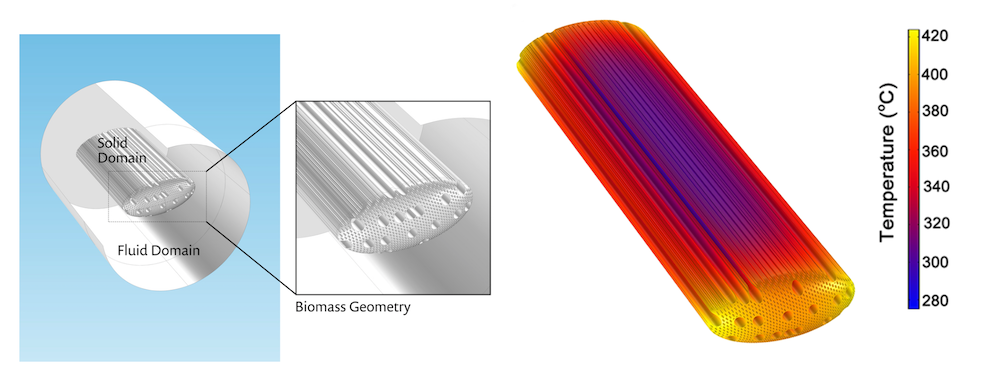
Model geometry featuring a fluid domain surrounding a hardwood biomass particle (left). The temperature distribution from a transient simulation of conjugate heat transfer (right).
Read the full story here: “Making Biofuel a Cost-Effective, Renewable Source of Energy”
More Examples of Using Simulation to Help the Environment
Want to learn more about how simulation relates to environmental applications? Check out these related blog posts:



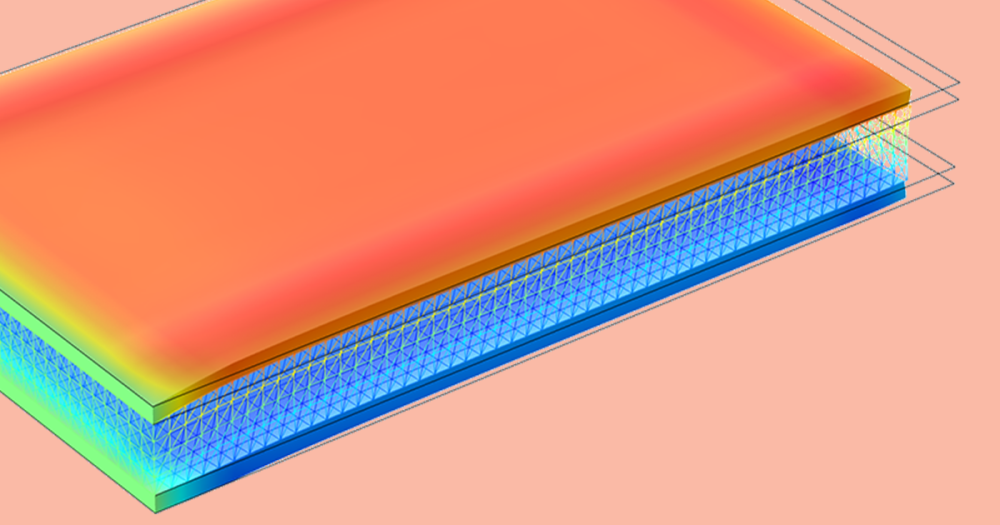
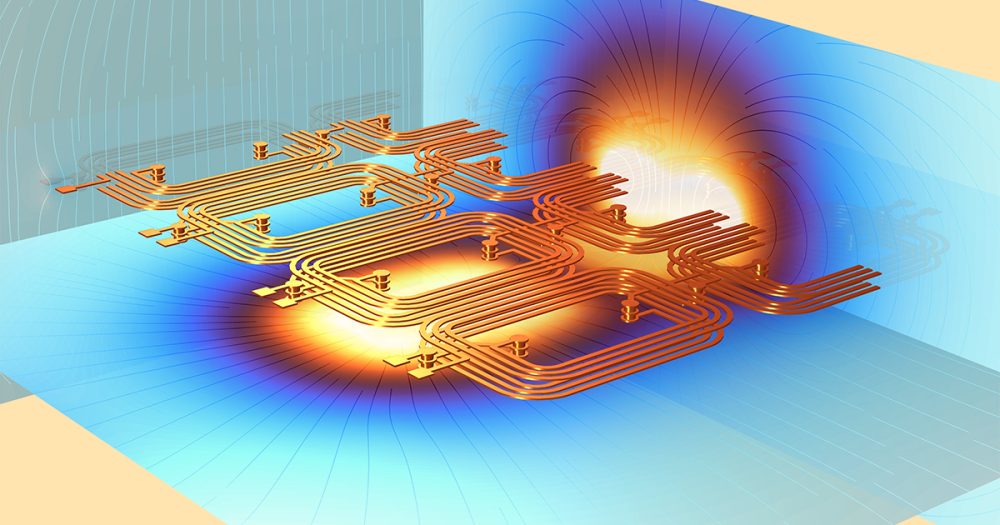
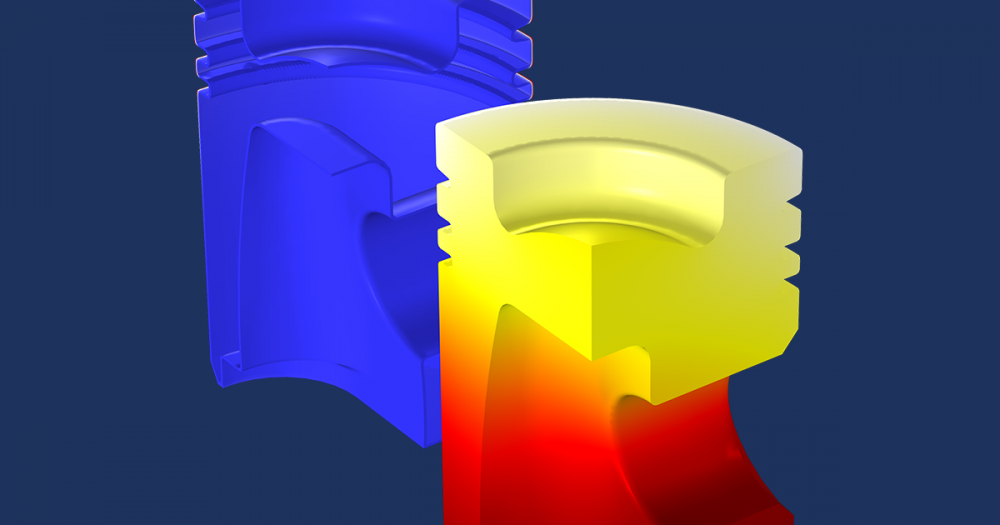
Comments (0)